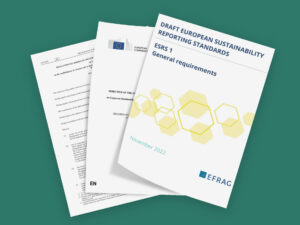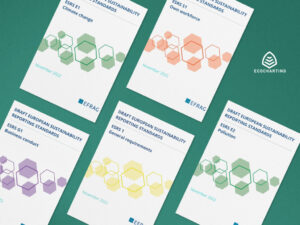The Corporate Sustainability Reporting Directive (CSRD) mandates businesses to disclose non-financial data about their operations. The information to be disclosed is determined based on a double materiality assessment. Considering that the CSRD regulations include over 1100 data points which must possibly be covered, determining which information is relevant is obviously a crucial step.
The double materiality concept is a central element in the CSRD. In short, the double materiality assessment is a way to identify which topics are most relevant to the organization and is required by the CSRD as a start to building a sustainability report.
So what does this mean?
The organization must assess all Environmental, Social and Governance (ESG) topics from two perspectives: the impact perspective and the financial perspective. Hence, the name is double materiality. The impact perspective helps identify the potential positive and negative effects an organization may have on the environment, whether already in effect or potentially arising in the future.
On the other hand, the financial perspective requires organizations to evaluate ESG topics based on their possible financial effects. By identifying financial risks and opportunities within a particular domain, the organization can determine which topics are relevant to their situation.
The result:
Once the organization has identified the impacts, risks, and opportunities (IRO) associated with the list of ESG topics, it needs to select the most material ones. This shortlist serves as the foundation for a sustainability report.
In sustainability reporting, transparency is key. The mandatory double materiality assessment should ensure that companies cannot simply choose topics that are convenient. Moreover, the assessment process needs to be well-documented.

Let’s investigate an example to make sure we all understand what this means.
For this example, let’s take the topic “Privacy of consumers”, which is a subtopic within the Social domain. First, the organization identifies possible positive or negative impacts on this topic. In this case, the organization might find out that their products or services impose negative impacts, namely on the privacy of consumers. From a financial perspective, there might be possible risks. For instance, consumers might boycott the product because of privacy concerns, and hence, the financial return might decrease over time. Taking all these effects into account and examining these Impacts, Risks and Opportunities (IROs) closely, the organization will find out whether Privacy is a material topic that warrants reporting on or not.
Understanding the concept of Double materiality is not overly complicated. However, in its practical application, there are several challenges that must be considered. Just to state the obvious: determining the materiality of around 100 subtopics can amount to a high workload for organizations to manage.
Besides, the process must be re-evaluated yearly. To achieve this, an intuitive and user-friendly system for materiality assessment is essential. That’s where Ecocharting comes in. Using our software, organizations can easily perform the double materiality assessment and receive instant results. If you’re interested in trying out our tool, don’t hesitate to contact us or request a demo.
Start CSRD Preparations today. Request a demo.
Get a personalized tour of our intuitive CSRD software. Request a demo right away.



